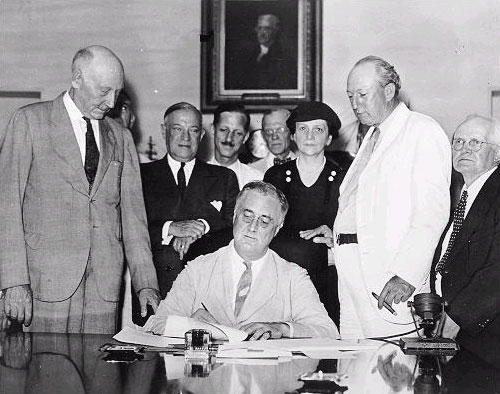Live
long and prosper
On August 14, 1935, President Franklin Delano Roosevelt signed into law one of the most effective federal programs in our nation’s history. For the better part of a century, Social Security has successfully prevented tens of millions of seniors, people with disabilities, and their dependents and survivors from falling into poverty.
This program remains a vital core benefit, with a solid track record of keeping misfortune and income loss from becoming a disaster for millions of Americans.
Social Security is on track to pay full benefits until 2034; and if rational, progressive measures are taken to ensure the program’s adequate funding before then, it will continue to do so thereafter. And we shouldn’t wait.
Now is the time to strengthen Social Security, secure its long-term stability, and expand its benefits in ways that address the inequities that still exist both inside and outside the program.
When Social Security was created, nearly 50 percent of seniors lived below the poverty line. Today, fewer than ten percent of seniors live in poverty.
Social Security’s importance is only increasing, given the decline of traditional pension benefits. It is also important to remember that Social Security is an insurance program, not just a plan for retirees.
It provides a disability insurance benefit that cannot be purchased on the private market. More than ten million American received disability benefits in 2017. While people may believe they will never need this benefit, a 20-year-old today has a 25 percent chance of receiving disability benefits in their lifetime.
The program also provides a separate benefit to young dependents and survivors of workers who have qualified for disability and old age insurance. Finally, while everyone benefits from Social Security, its progressive benefit formula is designed to replace more income for people who earned less over their working careers.
Social Security’s structure does help to address some glaring inequities. Black and Latinx workers earn far less on average than white workers.
Social Security’s structure does help to address some glaring inequities. Black and Latinx workers earn far less on average than white workers.
According to the Bureau of Labor Statistics, Black men earn 72 cents for every dollar a white man earns, Black women earn 65 cents, Latino men earn 69 cents, and Latina women earn 61 cents. A progressive benefit formula helps to address this inequality.
Also, according to the Social Security Administration, Black workers make up 12% of the population but 13.9% are disabled. While we need to address the underlying problems causing this disparity, it highlights the importance of Social Security’s disability, dependent, and survivor benefits. Latinx workers also have longer life expectancy, but lower income, so Social Security’s progressive benefit combined with an annual cost of living adjustment is especially helpful.
But other inequities persist. Workers of color and women are more likely to have gaps in their work history, for reasons that include the effects of structural racism and sexism.
But other inequities persist. Workers of color and women are more likely to have gaps in their work history, for reasons that include the effects of structural racism and sexism.
So we must continue to combat systemic discrimination in all of its forms. We must also prevent misclassification of workers as independent contractors and expand access to social insurance to all workers.
It is now up to us to protect and strengthen Social Security so that it may remain the great legacy of its principal architect, Frances Perkins, FDR’s Secretary of Labor, when she said: “One thing I know: Social Security is so firmly embedded in the American psychology today that no politician, no political party, no political group could possibly destroy this Act and still maintain our democratic system. It is safe. It is safe forever, and for the everlasting benefit of the people of the United States.”
Working together, we can shore up and expand the program to keep our promise to seniors and people with disabilities for another 83 years—and beyond.
Working together, we can shore up and expand the program to keep our promise to seniors and people with disabilities for another 83 years—and beyond.
